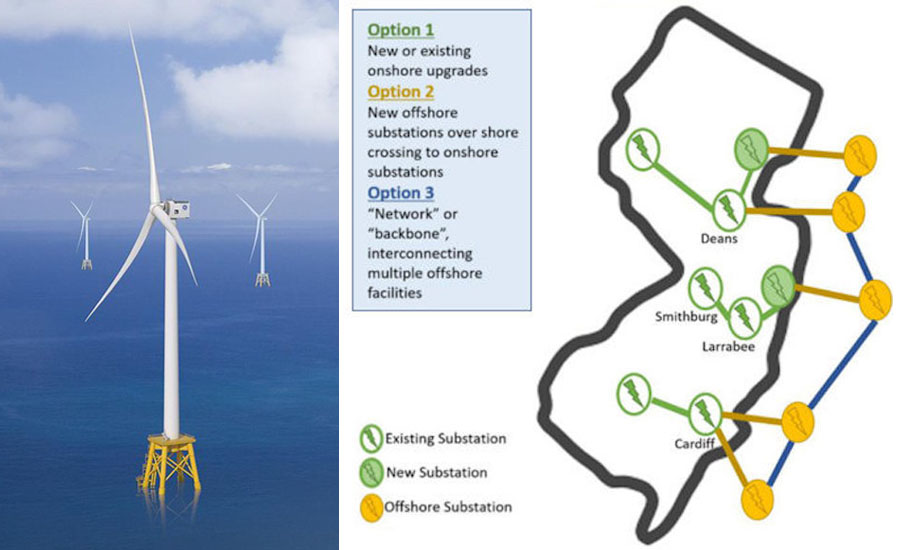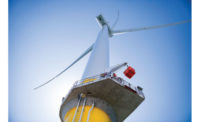Massachusetts, NJ Push New Offshore Wind Energy Infrastructure

New Jersey seeks new round of developer proposals for ocean-to-grid offshore wind transmission options (right) to link planned large scale turbines to be built in projects now under state and federal review.
Images: LM Power Inc. left; and NJ Dept. of Public Utilities (right)
Massachusetts and New Jersey took major steps to increase offshore wind production along the Atlantic Coast—announcing new solicitations for more power generation and added grid connection options, as well as initial construction permits granted for a major project.
The Massachusetts Dept. of Energy Resources said it seeks regulatory approval by the state utilities agency of a request for proposals in a fourth-round solicitation of up to 3.6 GW of offshore wind, with any one bidder able to offer between 200 MW and 2.400 GW. Bidders can propose projects in up to four phases and can pair them with energy storage systems. Contract terms would be 15 to 20 years.
Gov. Maura Healey said the latest round would account for about one-quarter of annual state power needs.
Proposals must include all transmission upgrade costs required to ensure full delivery of proposed generation, including onshore grid fixes that may be needed beyond interconnection points, the state says.
The state energy agency included an option in the RFP document meant to mitigate, or avoid, recent issues caused by inflation, higher interest rates and rising supply chain costs that now threaten economic viability of two 1.2-GW projects approved in the third-round solicitation.
Avangrid, developer of the Commonwealth Wind project, now seeks to rescind its accepted proposal because costs exceed its previously set power supply price. Market observers speculate that the SouthCoast Wind project being developed by Shell New Energies and Ocean Winds may follow suit, but those firms have not publicly stated their plans.
Developers of both projects and state officials are negotiating next steps. Commonwealth Wind was selected with a bid of $72 per MWh, a U.S. record low.
Cost Index Adjustments
The new RFP includes an indexing adjustment to increase or decrease an indexed cost up to 15% based on “a set of macroeconomic and/or commodity indices,” it says, adding that indexing would occur one year after contract approval.
“Price indexation is a paradigm shift necessary for the offshore wind industry to flourish. It will give developers confidence they can deliver economically viable projects, while shielding electricity consumers from developers achieving irrational profits,” Eric Thumma, vice president of new offshore business for Avangrid, said in comments to the state utilities agency.
Bidders also may propose price decreases or increases based on federal or state tax credits or subsidies, the RFP said.
But the RFP also requires bidders to disclose “past terminated projects and claims of financial difficulties,” with potential penalties assessed in the procurement process. Any proposers that have defaulted on or terminated a power purchase agreement also must provide added financial security, says the state. But if Avangrid or Shell/Ocean Winds take that step officially, they are not barred from fourth-round submittals, as some legislators had sought.
The document also requires details on how bids would use allowed federal tax credits and provides submittal flexibility “if IRS program guidance on the Inflation Reduction Act [IRA] is announced late in the bid preparation timeline.” The RFP also credits economic development plans in bids that support minority- and women-owned businesses and environmental justice communities.
Out to Bid in June
The RFP should go out to bid in June, with bidders that have ocean leases off Massachusetts—Avangrid, Orsted, Equinor, Shell/Ocean Winds and Copenhagen Infrastructure Partners—having until Jan. 31, 2024 to submit. Winners are set to be announced by the following June, and 15- to 20-year contracts with state utilities must be signed, reviewed and approved in the fall of 2024. Projects must begin operation by Jan. 1, 2032.
Sen. Michael Barrett of Lexington, Senate chair of the Legislature’s Telecommunications, Utilities, and Energy Committee, raised concerns about potential for higher power prices as a tradeoff for onshore economic development, noting the potential hurdles in transitioning from fossil fuels, said Commonwealth magazine.
New Jersey Seeks Ocean Links
In New Jersey, the Board of Public Utilities in late April asked grid operator PJM Interconnection to include the state’s current public policy of 11 GW of offshore wind by 2040 in current regional transmission expansion planning.
For the second time, the state is joining with the grid operator, under an approach created three years ago, to solicit bids to build an offshore wind transmission system. New Jersey used the process to award $1.1 billion of onshore infrastructure upgrades to accommodate 7,500 MW of offshore wind projects.
“Today’s action is extremely important for the future of our offshore wind program,” board President Joseph Fiordaliso said April 26. “We must create additional pathways for wind energy to be brought on shore and into the PJM grid.”
The new request is set to accommodate another 3,500 MW, Jeffrey Shields, a PJM spokesman told ENR. “The state will use our personnel and expertise but will still call the shots,” he said, referring to the state’s ability to decide whether to accept the grid operator’s recommendations.
PJM will include New Jersey’s request in a competitive proposal tentatively set for 2024. Bids could include grid to onshore substations, onshore substations to offshore collector farms or an offshore transmission backbone, PJM said (see map graphic).
Rules include substantial cost protections for ratepayers and reduced environmental and community impacts, the board says.
In its first transmission selections last October, the state did not select more extensive ocean-based interconnections presented by some of the 13 submitters, with federal tax credits for those under the Inflation Reduction Act not available then. Whether they will be set at completion of the state’s next transmission proposal round remains unclear.
The utilities agency also directed its staff to accelerate transmission discussions with other East Coast states that have offshore wind programs, and with federal and grid officials, about a regional offshore wind transmission system, including a regional backbone, for more cost sharing of a buildout that could cost tens of billions of dollars.
The state Dept. of Environmental Protection also in late April issued initial construction and operation permits to the 1,100 MW Ocean Wind 1 project, being developed by Orsted, including a confirmation that it would cause "no damage" to the coastal environment. Orsted called the approvals “critical steps” to advance the project and saw them as proof that impacts on the state’s natural resources will be minimal.
The state plans two Orsted projects off its coast. The second Ocean Wind project is 1,148 MW.
In a May 4 market report, the American Clean Power Association said offshore wind projects in the U.S. pipeline now total more than 51 GW in 32 leases off the Atlantic and Pacific coasts, and in the Gulf of Mexico. More than 16.5 GW are in advanced development, with 33.9 GW in early stages.
New York and New Jersey lead the country with 4.36 GW and 3.75 GW, respectively, in development.
The group also said 14 land-based facilities to support the offshore wind supply chain are planned or under construction, with more than $1.7 billion in investments for industry component production announced and three solicitations pending.
But the analysis also notes significant cost impacts from price rises for materials, particularly steel, and project permitting delays and other risks, which have pushed up wind levelized cost of energy in the U.S. 17% from an estimated $84 per MWh in 2021 to $98.5 per MWh so far this year. But with project movement set to drive economies of scale and efficiency in construction, the group predicts the cost of energy will drop to $90 per MWh by 2030.
•





